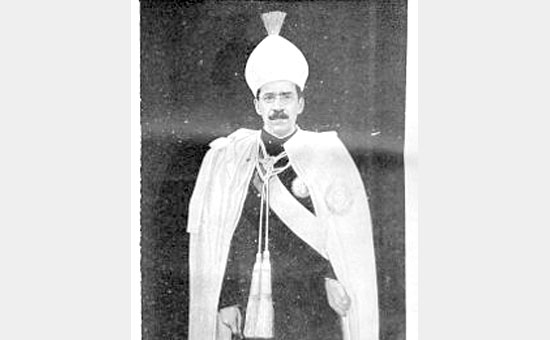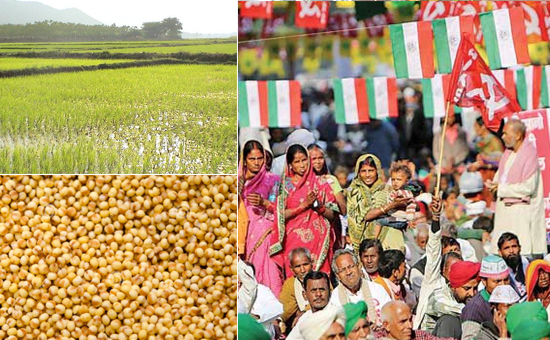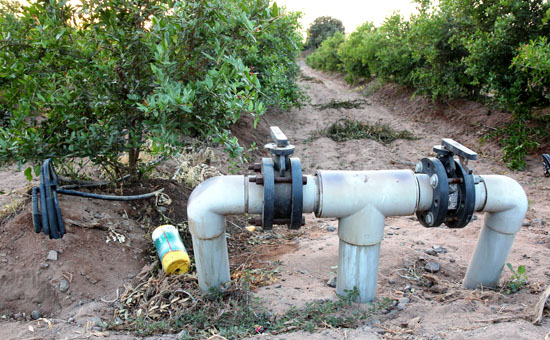- The deeper intent behind farmer income support is to hasten the process of digitalization of land records and collection of farm data.
- This articles gives eleven ideas on how data allows micro targeting of value services, financial and non-financial incentives.
Yesterday Prime Minister Modi launched the direct cash benefit scheme for farmers. The scheme was announced in the interim budget on February 1. It provided income support of Rs 6,000/ p.a. to Small and Marginal farmers (SMFs).
Post
the interim budget analysts debated the impact on the fiscal deficit of the Rs
75,000 cr PM-KISAN scheme and wondered if Rs 6,000/ was too small an amount to
make a difference. However, what has been being missed out is the BIG
POSSIBILITIES that might emerge if the scheme succeeds.
But first a background note.
Successive
central governments, including NDA 2, have been grappling with farm distress. None
of them have explained that –
One,
agriculture is essentially the responsibility
of the state government with their role being mainly limited to declaration
of MSP for wheat and rice-its procurement, deciding import export policy and
quantum of agricultural credit/interest subsidy. Crop insurance, disaster relief, technology
generation are largely managed by the Centre.
It is for this reason that the power to levy
income-tax on agriculture lies with the State governments.
Two,
realizing limitations imposed by the constitution NDA 2 gave states a model agricultural produce and livestock marketing (APLM)
law, 2017 that is intended to replace the existing APMC Act. And “a model agricultural land lease law, 2016. Not to forget a
draft model contract farming law, 2018 to mitigate these problems by allowing
absentee landowners to lease out land without fear of losing title.” 1
However,
every attempt at structural reforms has been stonewalled by the States. For e.g.
Maharashtra scrapped the APMC Act but reversed its decision in months.
At
the same time digitization of land records in states has not taken off despite
a ‘Digital India National Record Modernization Program’ that was funded by the
Central government.
 Nizam of Hyderabad Mir Osman Ali
Khan ruled the state
from 1911 until 1948
Nizam of Hyderabad Mir Osman Ali
Khan ruled the state
from 1911 until 1948
The
idea of income support to farmers caught the national imagination after the
success of the Rythu Bandhu
in Telangana. Many attribute KC Rao’s re-election to this scheme.
A background note on the system of land revenue in pre-independent India would be appropriate.
The
Ryotwari system prevalent in most of South India (British administered areas) meant
direct collection of land revenue from each individual cultivator by the government.
So land had to be measured and its owner known.
Conversely,
in Bengal, Bihar and Uttar Pradesh the Zamindari system was in vogue where the Zamindar
was responsible for collecting rent from peasants and remit it to the State. Thus,
the government did not have to maintain land records.
According
to Dr Gautam Pingle, Dean of
Studies & Head, Centre for Telangana Studies, MCR-HRD Institute of Telangana,
“State’s share of produce was 1/6th of produce under Hindu rule. Since Telangana was under Muslim rule-Nizam rate was 50% for non-Muslims. Since large parts of Andhra Pradesh were under British rule rate was 25%. In Travancore State rate was 10% and Cochin zero. This required the State to maintain land records.”
In
1985 N T Rama Rao, as Chief Minister of undivided Andhra Pradesh, abolished
land revenue so the need for updated land records was no longer required.
Subsequently Chandra Babu Naidu focused on digitization (excluding
land records) and introduced CARD (computer aided registration department) around 1998. When KC Rao introduced a grant of Rs 8,000/ per acre farmers, rich and poor, rushed to have their land records updated post which barcoded passbooks were issued.
Karnataka
started the Bhoomi project for
computerization of land records way back in 2002. According to the HINDU the second
phase of land document digitization started in October 2017. However, a scheme
similar to Rythu Bandhu was not started.
Notwithstanding
the above, pressure on the central government to resolve farm distress
continues unabated. Instead of undertaking reforms state governments are quick
to blame Delhi for farm distress. I call it Upward Delegation.
With
this backdrop the Pradhan Mantri Kisan Samman
Nidhi (PMKSN) was announced. The central government would, for the first time, single-handedly
and directly fund income support to SMFs.
 Farmer’s march in 2018
Farmer’s march in 2018
What are the broad contours of the scheme?
“Small and marginal farmer (SMF) families having combined
landholding/ownership of up to two hectares, as per the land records of the
States/UT, would receive support of Rs 6,000/ per annum. A family is defined as
husband, wife and minor children. The existing land-ownership system will
be used for identification of beneficiaries” 2
Having
an Aadhaar for availing benefits is mandatory. Where a SMF does not have Aadhar
or its Enrolment number alternate prescribed documents are stated. However, the
alternate allows SMF to receive the first instalment of support.
“Responsibility
of identifying the landholder farmer family eligible for benefit under the
scheme shall be of the State/UT Government. The States shall prepare database
of eligible beneficiary landholder farmer families in the villages capturing
the Name, Age, Gender, Category (SC/ST), Aadhaar Number or equivalent, Bank
Account Number, IFSC Code. Though mobile number is not mandatory but it is
advised that when available it may be captured so that the information related
to sanction/transfer of benefit can be communicated.” 2
Farmer
has an option of sharing - “Father name, Address, Mobile Number, Date of
Birth/Age, Farm-Size in Hectare, Survey Number, Khasra Number’. 2
State/UT
need to link farmer details with Aadhaar and bank details of the beneficiaries.
SMF data has to be uploaded by States/UT on PM Kisan Portal in a uniform
structure. This Portal shall give location wise data of benefitted farmers list
and monitor fund transaction details.
Whilst
digitization of land records may not be possible before the first pay-out, the desire
to receive income support would motivate farmers and state government to focus
on digitization.
Data collection and collation needs a phased approach.
In phase one the centre would have SMF name, aadhar and bank account numbers. It is assumed that farmers would, in their own interest, share mobile numbers if not part of the Aadhaar database already. This would enable the central and state governments to provide various advisory services to SMFs.
Once
data collection under phase one has stabilised, the government should continue
the income scheme but make a pre-condition that SMFs have to share farm-size,
survey number, seed sowed and actual production.
The
underlying idea behind this effort is information leads to data. Next data and
analytics allow micro targeting of value services, financial and non-financial
incentives.
How could this channel of communication and farm data be used
for the farmer’s benefit?
The
possibilities are enormous and would evolve with time. Here are some ideas.
One,
SMFs want income support and government transparency so PMKSN would hasten the process
of digitization of land records. I call this the bottom up approach. Once
digitization is complete it would increase availability of credit through formal
channels.
Two, state/district wise details of SMFs would enable better targeting of subsidy and advisory services support.
Three, when a region is adversely affected by a natural calamity it would enable quick transfer of funds to SMFs in affected areas.
Four, SMFs can receive advice for e.g. productivity, yields, fertilizer to use and what not to use.
Five, SMFs can receive real time information on trade and price, sell
anywhere in India and receive payment online. The message could have
appropriate links to the National
Marketing Portal
 Drip-irrigation needs to be promoted nationwide.
Drip-irrigation needs to be promoted nationwide.
Six, a message can be sent to farmers enlightening them on the methodology and benefits of drip-water irrigation.
Seven, states that provide free power to farmers can, based on this data, provide free power only to SMFs. Free power has contributed to depleting water tables.
When SMFs, in phase two, share details of what is sowed and actual production, more benefits might accrue.
Eight, the government can, in case of an over-supply, advice farmers to grow a crop in short supply.
Nine, fertiliser consumption based on farm area can be compared with fertilizer off take as captured by the point of sale terminals. This would be another way to reduce pilferage of subsidised fertilisers.
Tenant
farmers in Telangana are angry that benefits under the Rythu Bandhu scheme are denied to them. Solutions are two. Tenants reduce benefit
amount from rent payable to land owner. OR make it mandatory for
tenancy agreements to be registered online.
If the government is able to, in phase three, incentivise all farmers to provide details of sowing and actual production online additional benefits could accrue.
Ten, this would enable quicker consolidation and probably a more accurate way of estimating actual agricultural production.
Eleven, based on numbers collated under ten the government can advise farmers to adjust sowing of items in over or short supply. After all is not over-supply one of the reasons for farm distress.
None
should expect results of the above efforts in a hurry. This is a three-four
year project that requires constant communication in Indian languages
accompanied by close monitoring.
These
are only some possibilities of how farm data, collected through PMKSN, can be
used to smartly.
Using
data efficiently would increase farmer incomes,
make SMFs part of a larger agricultural eco-system, become a vehicle for two
way communication– farmer needs and advisory services, reduce pilferages and
contribute to farmer happiness.
The last thing one should do is to underestimate the enormity of the task ahead. After
all when the Jan Dhan Yojana scheme was announced sceptics wondered if it was
possible. 34.26 cr accounts were opened as on 12.2.2019. PMKSN is possible
because of accounts opened through JDY.
Let us look at the big picture, explore the unknown and
harness technology for the benefit of India’s agricultural sector.
JAI TECHNOLOGY JAI KISAN
References
1
MINT editorial
of 24/1/2018
2
PM-Kissan Samman Nidhi site
Also read
1 Looking beyond
loan write-offs for farmers
2 How Punjab’s
misplaced agricultural priorities contribute to Delhi’s pollution
3 Taxing
agriculture selectively is an idea whose time has come